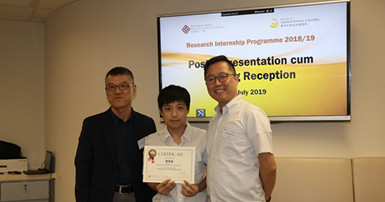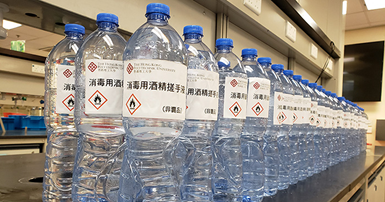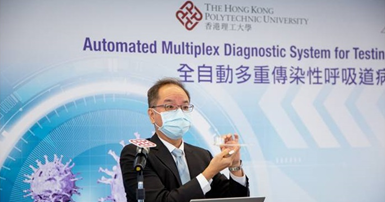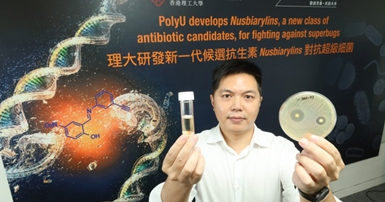PolyU develops a new class of antibiotic candidates for fighting against superbugs
The Hong Kong Polytechnic University (PolyU) has developed a new class of antibiotic drug candidates which has high potential to be developed into a new generation of antibiotics fighting against multi-drug resistant superbugs including methicillin-resistant Staphylococcus aureus (MRSA). The novel small molecules, based on new target, new chemical structure and new antimicrobial mechanism, are different from those of existing antibiotics. The new drug candidates demonstrate much effective abilities of inhibiting bacterial growth than commonly used antibiotics, yet with no toxicity to human cells.
Drug resistance has been declared as one of the biggest threats to global health in 2019 by the World Health Organization, with MRSA becoming one of the most serious concerns.[1] Hong Kong cannot be spared from the worsening scourge of MRSA. In 2018, there were 1,218 reported cases of community-associated MRSA (CA-MRSA), or a seven-fold of the figure in 2007 – the year the disease became notifiable in Hong Kong. [2] As of August this year, there were already 839 cases reported. Despite of tremendous pharmaceutical research and development investments worldwide, the search for new antibiotics has showed no progress since mid-1980s.
The development of "Nusbiarylins", a new class of antimicrobial agents, by the research team of the State Key Laboratory of Chemical Biology and Drug Discovery of PolyU's Department of Applied Biology and Chemical Technology (ABCT), is thus a breakthrough in the battle against multi-drug resistant bacterial infections. The interdisciplinary team, led by Dr MA Cong, Assistant Professor in ABCT, comprises of experts from both PolyU and Faculty of Medicine of The Chinese University of Hong Kong.
"Our research is now in the stage of animal studies, conducting infectious model studies and pharmacokinetic studies. These are the critical steps preceding clinical trials on human for drug development. At this moment, there are very few antibiotic related studies being able to complete such stage worldwide. Our findings so far are very promising. We believe further studies on these compounds will contribute to a new era of antibiotic discovery, contributing towards the fight against superbugs," said Dr Ma.
New target being identified by innovative antimicrobial mechanism
Most antibiotics currently in the market fight against bacteria through disrupting its DNA synthesis or protein functions. The innovative antimicrobial mechanism developed by PolyU team focuses on inhibiting the interaction between two proteins, NusB and NusE, which is crucial for synthesis of bacterial ribosomal RNA (rRNA). By designing small molecules to disrupt NusB-NusE interaction, bacterial cell proliferation can thus be curbed.
The team developed a model basing on the structure of NusB and NusE, and applied computer-aided screening to screen about 5,000 small molecule compounds with drug-like properties to explore for inhibitors for NusB-NusE interaction. The shortlisted compounds were then put to tests for antimicrobial activity against different MRSA strains. A compound, (E)-2-{[(3-ethynylphenyl)imino]methyl}-4-nitrophenol (hereafter addressed as MC4), was identified as having much effective antibacterial abilities than the commonly used antibiotics. The Minimum Inhibitory Concentration (note: MIC denotes the lowest concentration of a chemical/drug for preventing bacterial growth) of MC4 for some MRSA strains are as low as 8 μg/mL, compared to the MICs of >64 μg/mL demonstrated by two antibiotics in the market, oxacillin and gentamicin.
Test of MC4 on human lung and skin cells (infections caused by MRSA often occur in these tissues) indicated no significant toxicity. The fact that NusB and NusE exist only in bacteria and not human cells has also addressed toxicity concern.
"Nusbiarylins" — a new class of antibiotic candidates
The research team has further structurally modified MC4 for optimization, and 167 analogues were synthesized so far. The new class of compounds are named as "Nusbiarylins" (basing on their target protein "NusB" and their "biaryl" structure). Laboratory test of Nusbiarylins against a panel of MRSA strains proved their consistent antibacterial activity, some with MIC as low as 0.125 μg/mL, much better than commonly used antibiotics, including vancomycin with the MIC of 1 μg/mL which is labelled as the "last resort" antibiotic drug in the United States.
Further pre-clinical studies on the in vitro pharmacological properties of Nusbiarylins on human cells indicated that the compounds:
— leading to nearly no hemolysis (i.e. human blood cell breaking), an indication of being safe for injection; and
— with excellent result in intestine absorption, implying being effective for oral taking.
The findings have been recently published in leading scientific journals (listed below). The innovation has also won the "Global Innovation Award" at the TechConnect World Innovation Conference and Expo 2019 held in June in the United States.
Recently published journal papers:-
Xiao Yang, Ming Jing Luo, Apple C M Yeung, Peter J Lewis, Paul Kay-sheung Chan, Margaret Ip, Cong Ma. First-In-Class Inhibitor of Ribosomal RNA Synthesis with Antimicrobial Activity against Staphylococcus aureus. Biochemistry 2017, 56, 5049-5052.
Tsz Fung Tsang, Yangyi Qiu, Lin Lin, Jiqing Ye, Cong Ma, Xiao Yang. Simple Method for Studying in Vitro Protein–Protein Interactions Based on Protein Complementation and Its Application in Drug Screening Targeting Bacterial Transcription. ACS Infectious Diseases 2019, 5, 521-527.
Yangyi Qiu, Shu Ting Chan, Lin Lin, Tsun Lam Shek, Tsz Fung Tsang, Nilakshi Barua, Yufeng Zhang, Margaret Ip, Paul Kay-sheung Chan, Nicolas Blanchard, Gilles Hanquet, Zhong Zuo, Xiao Yang, Cong Ma. Design, Synthesis and Biological Evaluation of Antimicrobial Diarylimine and Amine Compounds Targeting the Interaction between the Bacterial NusB and NusE Proteins. European Journal of Medicinal Chemistry 2019, 178, 214-231.
Yangyi Qiu, Shu Ting Chan, Lin Lin, Tsun Lam Shek, Tsz Fung Tsang, Yufeng Zhang, Margaret Ip, Paul Kay-sheung Chan, Nicolas Blanchard, Gilles Hanquet, Zhong Zuo, Xiao Yang, Cong Ma. Nusbiarylins, a New Class of Antimicrobial Agents: Rational Design of Bacterial Transcription Inhibitors Targeting the Interaction between the NusB and NusE Proteins. Bio-organic Chemistry 2019, 92, 103203.
理大研發新一代候選抗生素對抗超級細菌 (Chinese)
South China Morning Post
Drug-resistant MRSA: Hong Kong scientists develop antibiotic that offers hope in the war against superbugs
5 Nov 2019
明路—生涯規劃 第65期
理大研發新候選抗生素 或成超級細菌剋星
15 Oct 2019
LabOnline
New antibiotic candidates for fighting superbugs
8 Oct 2019
中國數字科技館
香港理工大学研制新抗生素 或可对抗“超级细菌”
29 Sep 2019
生物通
香港理工大学研发新一代对抗超级细菌的抗生素
27 Sep 2019
北部灣線上
香港理工大学研制新抗生素 或可对抗“超级细菌”
26 Sep 2019
醫藥資訊
香港团队研制新抗生素 或可对抗“超级细菌”
26 Sep 2019
Ezone Ulifestyle
理大研發新抗生素 Nusbiarylins 對付耐藥性惡菌
25 Sep 2019
西安新聞網
港理大研發新一代候選抗生素有望抗超級細菌
25 Sep 2019
西安新聞網
香港理工大学研制新抗生素 或可对抗“超级细菌”
25 Sep 2019
健康界
香港团队研制新抗生素 或可对抗“超级细菌”
25 Sep 2019
BioSpectrum Asia
PolyU develops new class of antibiotic candidates against superbugs
25 Sep 2019
台海網
香港理工大学研制新抗生素 或可对抗“超级细菌”
25 Sep 2019
金羊網
香港理工大学研制新抗生素 或可对抗“超级细菌”
25 Sep 2019
大河網
香港理工大学研制新抗生素 或可对抗“超级细菌”
25 Sep 2019
新浪新聞
香港理工大学研制新抗生素 或可对抗“超级细菌”
25 Sep 2019
明報 A17
理大研發新候選抗生素 對抗超級細菌現曙光
25 Sep 2019
The Standard P10
PolyU team finds new hope in fighting superbug
25 Sep 2019
信報財經新聞 A15
抑制生長達治療效果
25 Sep 2019
香港經濟日報 A23
理大研發新抗生素Nusbiarylins更有效抑制細菌生長 有望對抗耐藥性細菌
25 Sep 2019
東方日報 A12
理大研發新抗生素對付超級惡菌 料5年內完成臨床測試
25 Sep 2019
香港01
理大研發新抗生素對付超級惡菌 料最快2年做臨床研究
25 Sep 2019
大公報 A17
理大研发新抗生素 专治耐藥性超级恶菌
25 Sep 2019
Science Daily
New class of antibiotic candidates for fighting against superbugs
24 Sep 2019
TVB
理大正研更有效抑制細菌抗生素 冀五年後推出市面
24 Sep 2019
Commercial Radio
理大研發新一代候選抗生素有望抗超級細菌
24 Sep 2019
Metro Radio
理大成功研發候選抗生素對抗超級細菌
24 Sep 2019







